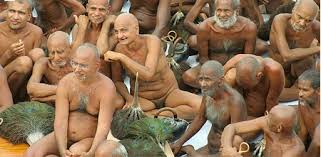1. Throwing Babies from a Tower for Good Luck (India)

For
500 years, worshippers at a Muslim shrine in western India have
continued the tradition of throwing babies from a 50-foot tower for good
luck.
The children are taken to the top of the building, thrown down onto a
bed-sheet held taut by men 50 feet below, and quickly passed through
the crowd to their mothers. The parents proudly throw down their
children due to a strong belief that the practice of this ritual blesses
their offspring with good health, luck, courage, and life-long
strength.
The annual celebration in observed by Muslims and Hindus in
the Indian state of Maharashtra, and it
also takes place in smaller
villages throughout the country.
Well, if your baby gets thrown off a 50-foot tower and survives, one would assume he’s indeed quite lucky.
2. Piercing by Sharp Hooks (India)

“Garudan
Thookkam” is a ritual art form performed in Kali temples in southern
India. The people who dress up as Garuda (a Hindu divinity) perform a
dance, and after the performance the backs of devoted Hindus are pierced
by sharp hooks. The men are then lifted off the ground onto a scaffold
using ropes, sometimes with babies in their hands, and taken around the
temple as a mark of offering to the Goddess.
3. Dissecting The Deceased’s Body and Scattering the Pieces on a Mountaintop (China)

Sky
burial is a funerary practice in Tibet wherein a human corpse is
incised in certain locations and placed on a mountaintop, exposing it to
the elements and animals, especially predatory birds.
Most Tibetans follow Buddhist traditions, which dictate that the
human body is merely a vessel and can be discarded. The practice was
eventually forbidden, but it can still be performed with the family’s
permission.
4. Being Possessed and Convulsing (Haiti)

Voodoo
worshipers believe that it is important to honor and care for all of
the spirits, as it is believed that they become weak over time and
depend on humans for nourishment. Rituals and sacrifices are used
to rejuvenate them; in other words, the life force of a sacrificed
animal will transfer to the spirit.
These rituals are done to gratify the gods, called “Loa.” An animal,
such as a sanctified chicken, is sacrificed in order to satisfy Loa,
which are sustained by the life energy that is released during the
sacrifice.
During the ceremony, worshippers can be “mounted,” or possessed, by a
Loa. The Loa will take complete control of the individual and will
offer advice, give cures, and deliver prophesies to the assembly. This
can be quite a violent occurrence, since the participant can flail about
or convulse before falling to the ground.
5. Baptizing a Person on Behalf of One Who is Dead

Baptism
for the dead is a Mormon practice of baptizing a person on behalf of
one who is dead. In other words, a living person receives the ordinance
on behalf of a deceased person.
Mormons believe that their minster has missionaries in the “spirit
world” who are busy spreading the Mormon gospel to dead people who have
not received it yet. Should any of these dead people want to convert
to Mormonism, they are required to abide by all of its rules, one of
which is baptism.
()
6. Wearing No Clothes and Using a Peacock Feather Duster (India)

Outward
appearance is seen by the Digambaras as an index of properly
understanding the doctrine, so a “true” monk must be completely naked.
He must abandon all possessions and no longer subject himself to the
social considerations of pride and shame. He drinks water from a gourd
and begs for his food. He can eat only once a day, as well.
In accordance with their practice of nonviolence, the monks also use
a peacock feather duster to clear their path of insects to avoid
trampling them.
Because women are not allowed to be naked ascetics, Digambaras
believe that they cannot reach the level of detachment needed to become
liberated. Therefore, a woman must be reborn in a male body to reach
liberation.
7. Rolling Over Leftovers of Food Partaken by Brahmins (India)

The
practice, said to be 400 years old, involves people rolling
over plantain leaves containing leftovers of meals consumed
by Brahmins in the belief that all troubles and ailments will be cured.
The Karnataka government informed the High Court that it has decided
to modify the controversial practice at the Kukke Subramanya temple.
From now on, food not tasted or eaten by anybody will be placed
on plantain leaves in the outer yard of the sanctuary.
8. Practicing Group Sex and Masturbation

A
secret group in the Seattle area practices Pagan rituals to appease the
spirits of fertility and fruitfulness through sex rites that were
practiced in the ancient Middle East over 1,500 years ago.
The spirits cannot enjoy orgasmic sensation within their own
non-corporeal bodies, but they can feel the ecstasy of human pleasure
through these rites. The practitioners have heterosexual and homosexual
sex at the same time and in the same room, with the goal of achieving
climax all together so that society retains the spirit relationship and
is blessed. The spirits can also be appeased through masturbation with
no intercourse.
No comments:
Post a Comment
please drop a comment and let me know what you think.